Introduction
In a world increasingly driven by technology, automation emerges as a game-changer, reshaping the landscape of operational efficiency across various industries. From reducing the burden of repetitive tasks to enhancing decision-making through intelligent systems, the integration of automation is no longer a luxury but a necessity for organizations striving to stay competitive.
However, the journey to successful automation is fraught with challenges, including:
- Resistance to change
- The complexities of integrating new technologies with legacy systems
This article delves into the essentials of automation, its intersection with artificial intelligence, and a practical guide to implementation, equipping organizations with the knowledge to navigate potential pitfalls and unlock the full potential of their operational capabilities.
By embracing these strategies, businesses can transform their workflows, improve productivity, and foster a culture of innovation that thrives in the face of constant change.
Understanding the Basics of Automation
The use of technology involves understanding how does automation work by integrating systems to perform tasks with minimal human involvement, significantly altering operational environments across industries. It can manifest in various forms, from straightforward scripts that automate routine functions to sophisticated systems that orchestrate entire workflows seamlessly. Key aspects of automation include:
- Definition: At its core, automation serves to streamline processes, drastically reducing manual effort and enhancing overall efficiency. Robotic Process Automation (RPA) illustrates how does automation work by automating routine tasks and improving accuracy, which frees employees to focus on strategic initiatives.
- Purpose: The primary objective is to eliminate repetitive tasks, thereby improving accuracy and allowing employees to dedicate their expertise to more strategic initiatives. As Pierre Nanterme aptly stated, “Digital is the main reason just over half of the companies on the Fortune 500 have disappeared since the year 2000,” which emphasizes the critical need for businesses to understand how does automation work in adopting automated processes.
- Industry Impact: Digitalization and mechanization are transforming the services industry, affecting all sectors and necessitating a proactive approach to adapt to these changes. In healthcare, for example, GUI mechanization has been demonstrated to greatly improve operational efficiency by decreasing data entry mistakes by 70% and speeding up testing activities by 50%.
- Challenges: However, companies often face challenges in adopting automated processes, such as resistance to change, integration with legacy systems, and the need for skilled personnel. Tailored AI solutions can help address these challenges by providing customized approaches that align with specific business needs.
- Business Intelligence: Utilizing business intelligence along with automated systems can further improve decision-making methods, enabling organizations to convert data into actionable insights that stimulate growth.
- Examples: Automation finds its application in numerous areas, including email marketing campaigns that nurture leads, data entry tasks that minimize errors, and inventory management systems that optimize stock levels. Moreover, platforms such as Tigersheet, a no-code solution, assist in automating and streamlining business processes effortlessly, making these tools accessible to a broader array of enterprises. These examples demonstrate how does automation work by showing how successful mechanization can result in significant enhancements in operational effectiveness and workforce productivity.
- Case Study: A recent case analysis demonstrated how a mid-sized company enhanced productivity by utilizing GUI technology to address issues like manual data entry mistakes and sluggish software testing, resulting in an 80% improvement in workflow productivity and attaining ROI within 6 months. The article titled “Effective Strategies for Efficiency” suggests that businesses should focus on how to manage repetitive tasks rather than who should manage them. By evaluating workflows and recognizing opportunities for automation, businesses can enhance processes and increase productivity.
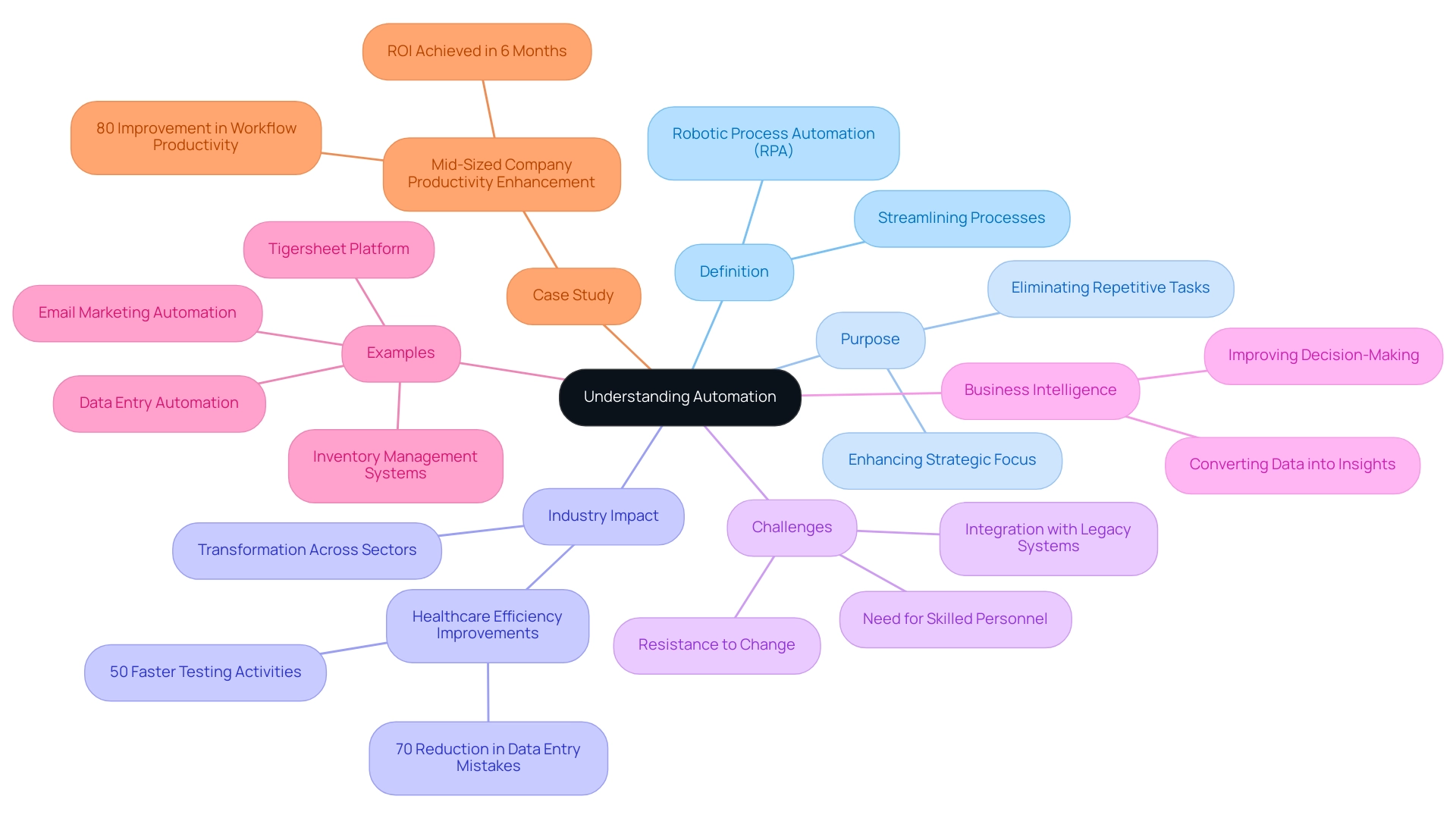
The Intersection of Automation and Artificial Intelligence
Mechanization and Artificial Intelligence (AI) are closely connected but fundamentally distinct ideas that serve essential functions in operational productivity. Understanding these distinctions is essential for effective implementation:
- Automation refers to the execution of predefined tasks without the need for human intervention. This procedure is intended to enhance efficiency and reduce mistakes in repetitive tasks, illustrating how does automation work. Our Robotic Process Automation (RPA) solutions, such as EMMA RPA and Microsoft Power Automate, exemplify this by streamlining workflows, alleviating the burden of manual, repetitive tasks, and addressing issues like task repetition fatigue and staffing shortages.
- Artificial Intelligence, on the other hand, encompasses the development of systems that can mimic human intelligence, allowing machines to learn from data and make informed decisions. John McCarthy succinctly captures this relationship by stating, “Artificial intelligence is the science of making machines do things that would require intelligence if done by humans.”
The integration of AI into automated processes helps illustrate how does automation work, significantly enhancing their capabilities. By introducing cognitive functionalities, AI empowers automated systems to adapt and optimize workflows, prompting us to explore how does automation work based on real-time data analysis. For instance, chatbots exemplify this integration; they automate customer service interactions while continuously learning from each engagement, ultimately improving user experience.
As we look toward 2024, the statistics reflect a growing trend: over half of Fortune 500 companies have vanished since 2000 due to the pressures of digitalization. This emphasizes the urgent need for effective mechanization strategies to overcome outdated systems and enhance productivity. Moreover, addressing potential conflicts of interest arising from technological anxiety among employees is crucial for fostering a culture of innovation and adaptability within organizations.
The ‘Predictions of Singularity‘ further emphasize the profound changes that may occur if AI surpasses human intelligence, highlighting the importance of carefully considering AI’s development and its implications for the workforce. EMMA RPA, featuring its user-friendly interface and diverse applications, transforms processes by enhancing operational efficiency. Power Automate, with its AI-powered capabilities, connects apps and data to streamline workflows, ensuring that businesses can adapt to modern challenges effectively.
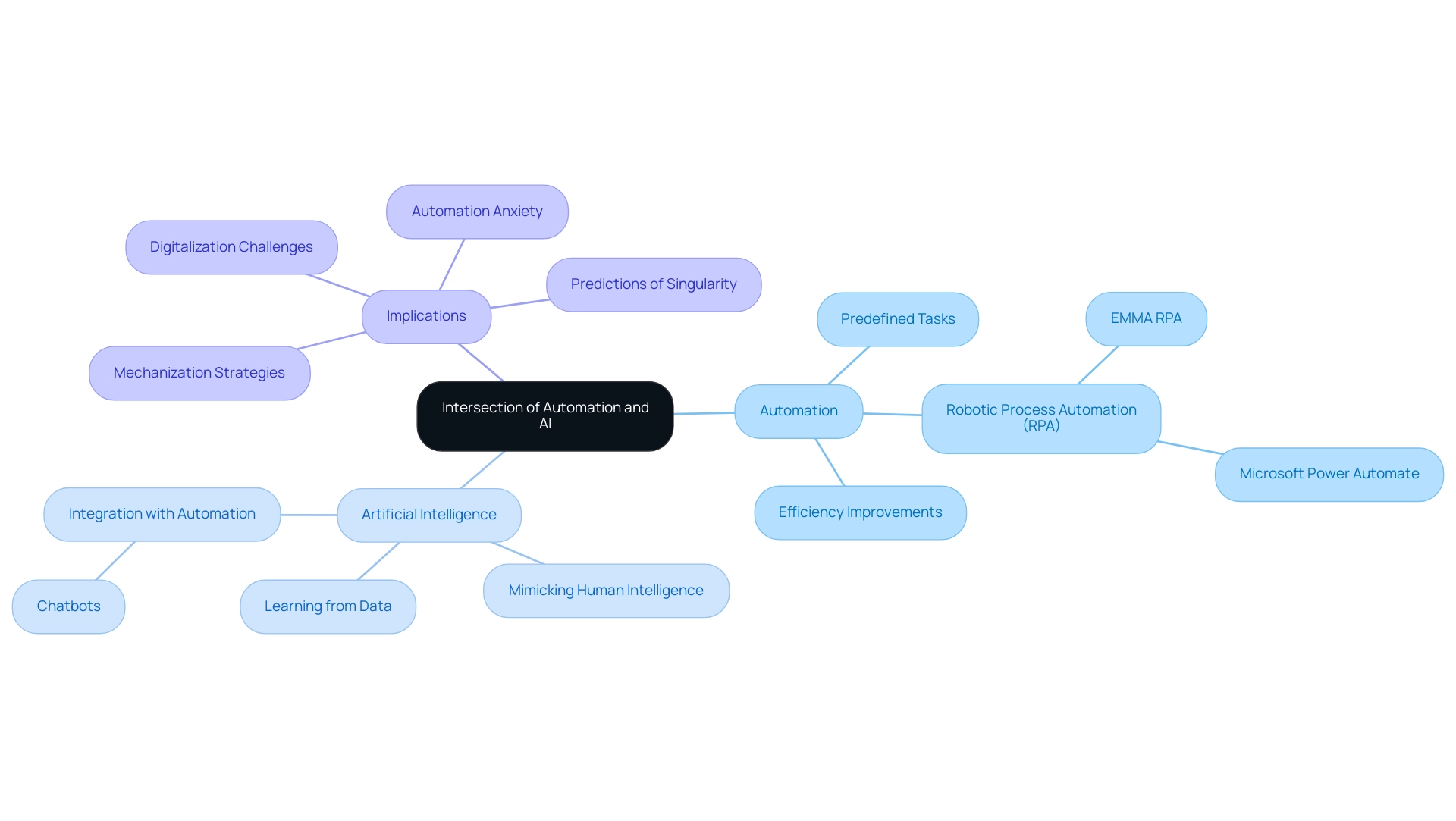
A Step-by-Step Guide to Implementing Automation
To implement mechanization effectively in your organization, follow this comprehensive step-by-step guide:
-
Identify Repetitive Tasks: Begin by conducting a thorough analysis of your workflows to pinpoint tasks that are not only time-consuming but also susceptible to human error. Recognizing that these tasks may also benefit from manual testing ensures that you can uncover issues that automated tests may miss. This foundation will help prioritize which processes to automate first, addressing common workplace challenges that can diminish morale and productivity, thereby explaining how does automation work.
-
Set Clear Goals: Establish specific objectives for your mechanization efforts to clarify how does automation work. Whether your emphasis is on lowering operational expenses, boosting productivity, or refining service delivery, having clear objectives will steer your technological strategy. It’s essential to include goals related to maintaining quality through manual testing, as it remains necessary to verify that business requirements are met, especially in an environment where talent retention can be a challenge due to difficulties in attracting and retaining the right personnel for operational roles.
-
Choose the Right Tools: Conduct detailed research to select tools for mechanization that align with both your organizational goals and your existing technology stack. Look for tools that offer scalability, ease of integration, and robust support to ensure a smooth transition. These tools should not only aid in mechanization but also improve the overall effectiveness of your operations, particularly in learning how does automation work to address the difficulties presented by obsolete systems that can hinder workflows and suppress innovation.
-
Develop a Pilot Program: Initiate a small-scale pilot program to test the chosen mechanization process. This trial run helps you explore how does automation work in identifying potential challenges and refining your approach before committing to a full-scale implementation. During this phase, incorporating manual testing can help to validate the effectiveness of the automated processes and ensure that your team is prepared for the changes ahead.
-
Train Your Team: Equip your team with the training necessary to thrive in an automated environment. Promoting ongoing learning and adaptation is essential to nurture a culture of innovation and productivity, as it helps teams understand how does automation work. Training should also address the significance of manual testing as a component of your overall strategy, supporting the aim of maximizing productivity while minimizing errors.
-
Monitor and Optimize: Establish metrics for success and continuously track performance. Consistently assess the results of the processes and implement data-informed modifications to improve both efficiency and effectiveness. This involves evaluating the role of manual testing in your ongoing activities, ensuring that your organization stays agile and responsive to changes in workflow demands.
-
Incorporate Manual Testing: Acknowledging that mechanized processes have their boundaries, it’s essential to integrate manual testing into your procedures. As noted by Priyanka Sharma, a Senior Systems Software Engineer at NVIDIA,
Manual testing is the only way to verify that the business requirements are successfully met and the customer gets the desired experience.
This balance guarantees that quality is upheld while utilizing the advantages of technology, ultimately boosting business productivity through Robotic Process Automation (RPA), customized AI solutions, and actionable insights.
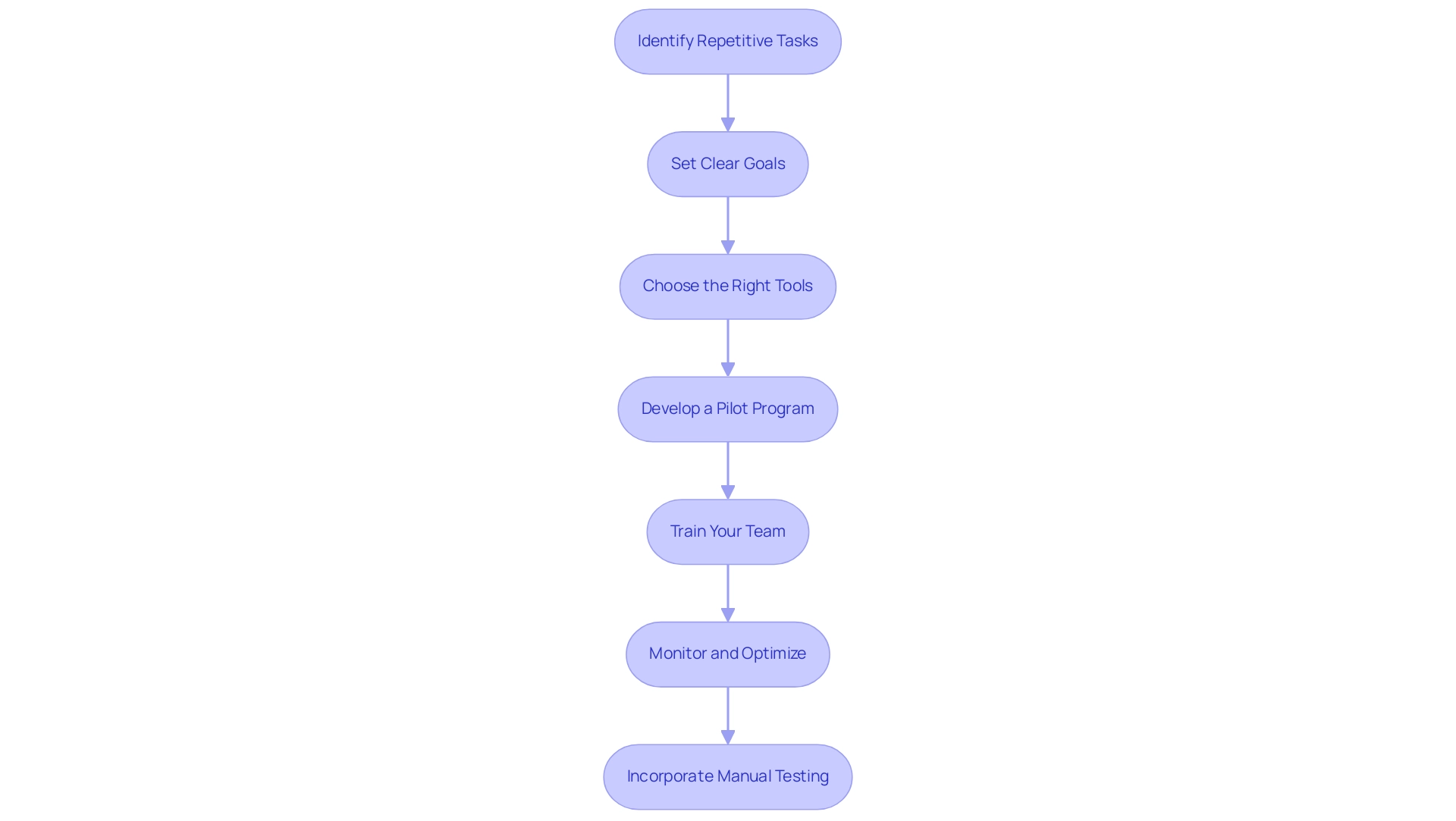
Exploring Different Types of Automation Technologies
When examining automated technologies, it’s crucial to comprehend the varied choices accessible, each customized to particular organizational requirements:
- Robotic Process Automation (RPA): This groundbreaking technology streamlines repetitive tasks through software robots that imitate human actions, significantly enhancing productivity and enabling employees to shift their attention toward more strategic activities. RPA allows organizations to tackle manual workflow challenges, thereby improving operational performance in a rapidly evolving AI landscape, which demonstrates how does automation work. However, organizations should be aware of high initial setup costs and potential resistance from workers when implementing RPA.
- Business Process Automation (BPA): BPA streamlines complex business processes involving multiple systems and stakeholders, improving operational efficiency and fostering interdepartmental collaboration, which helps to understand how does automation work.
- IT Process Automation (ITPA): ITPA automates essential IT operations, such as system monitoring, backups, and incident response, illustrating how does automation work to reduce downtime and optimize resource management.
- Workflow Management: This technology simplifies business workflows by managing the flow of information and tasks among various systems and users, illustrating how does automation work to promote a seamless operational environment.
- How does automation work: By integrating AI capabilities into processes, organizations can enhance decision-making and adapt based on data insights, which illustrates how automation work towards smarter operations. Customized AI solutions can assist in tackling particular business challenges, ensuring that the systems implemented align with organizational goals.
As pointed out by Mikell P. Groover, a notable figure in industrial engineering, > Another significant advancement in the history of mechanization was the Jacquard loom, which showcased the idea of a programmable machine <. The Jacquard loom, created by Joseph-Marie Jacquard around 1801, was able to produce intricate designs in textiles, demonstrating the early influence of mechanization on manufacturing. This historical viewpoint, together with Charles Babbage’s suggestion of the mechanical ‘analytical engine’ in the 19th century, demonstrates the progression of mechanization and its foundational role in contemporary technology.
The advantages of mechanization in manufacturing include increased productivity, reduced labor costs, improved quality control, and enhanced safety, while challenges such as high initial setup costs and potential resistance from workers are important considerations for organizations.
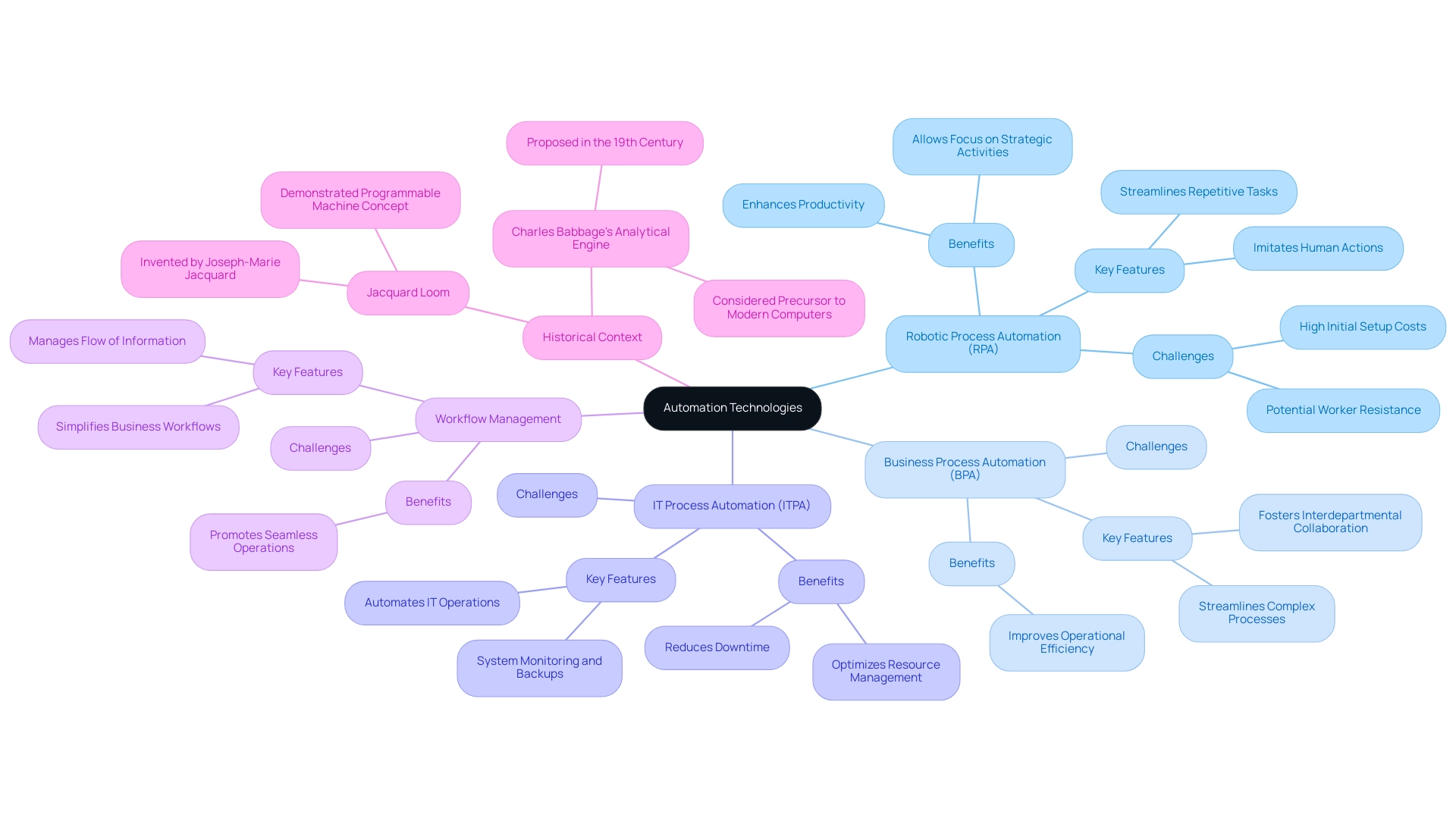
Navigating Challenges in Automation Adoption
Understanding how does automation work is crucial, as embracing automated technologies can present several challenges that organizations must navigate effectively to ensure a smooth transition. Key obstacles include:
-
Resistance to Change: Employees often express hesitance towards new technologies. A case study titled ‘Streamlining Operations with GUI Automation’ illustrates how does automation work, as a mid-sized healthcare company faced initial resistance to systemization in data entry and software testing.
By involving team members in the decision-making process and providing comprehensive training, the company empowered its workforce to embrace these new tools, leading to a 70% reduction in data entry errors. -
Integration Issues: Ensuring that new mechanization solutions integrate seamlessly with existing systems is a significant hurdle. For the aforementioned company, understanding how does automation work through thorough compatibility assessments prior to implementing GUI mechanization helped identify potential conflicts, particularly with outdated systems lacking APIs, and address them proactively, resulting in enhanced software quality and a 50% acceleration in testing processes.
-
Lack of Clear Objectives: Mechanization initiatives without defined goals are likely to struggle. Establishing specific, measurable objectives at the outset guided the healthcare company’s process optimization efforts, motivating the team and aligning their actions towards common goals, ultimately achieving an 80% improvement in workflow efficiency, which illustrates how does automation work to generate a return on investment within six months.
-
Data Quality Concerns: Reliable systems are built on accurate data. Investing in data cleansing and management practices is crucial to eliminate inaccuracies, which helps in understanding how does automation work to ensure that the outputs produced by automated tools reflect the best possible quality.
-
Ongoing Maintenance: Automated systems require regular maintenance and updates to perform optimally. Developing a long-term support plan that includes scheduled evaluations and upgrades ensures sustained effectiveness and adaptability in the face of evolving needs, and understanding how does automation work is crucial for overcoming resistance to change, requiring a combination of user-friendly tools and effective change management to foster a culture of adaptability in organizations.
Our GenAI workshops focus on enhancing business operations with personalized AI experiences, hands-on training, integration strategies, and ethical usage, directly addressing the automation challenges faced by the healthcare company and emphasizing that embracing change is essential for growth and innovation.
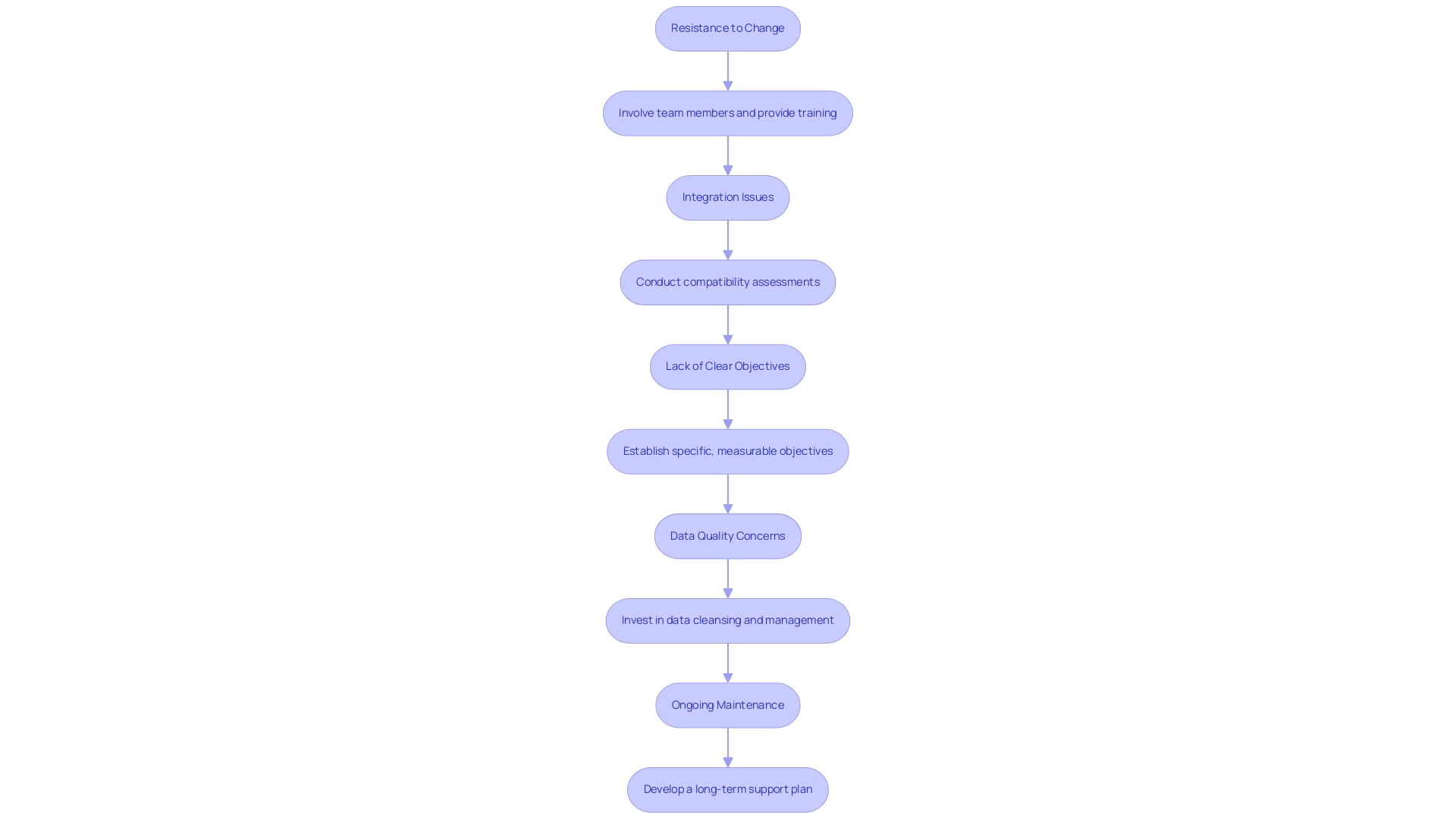
Conclusion
Embracing automation is not merely a response to the demands of modern industry; it is a strategic imperative for organizations seeking to thrive in an increasingly competitive landscape. By understanding the fundamentals of automation, its intersection with artificial intelligence, and the various technologies available, businesses can effectively streamline operations and enhance productivity.
The journey toward successful automation involves:
- Identifying repetitive tasks
- Setting clear objectives
- Choosing the right tools to facilitate integration
Implementing a pilot program and investing in team training ensures that organizations are well-prepared to leverage automation effectively. Moreover, recognizing and addressing challenges such as resistance to change and integration issues are crucial in fostering a culture of innovation and adaptability.
Ultimately, the successful implementation of automation not only transforms workflows but also empowers employees to focus on strategic initiatives that drive growth. By committing to this transformative journey, organizations can unlock new levels of operational efficiency, paving the way for sustained success in the face of evolving market demands. Now is the time to take action, harness the power of automation, and redefine the future of work.